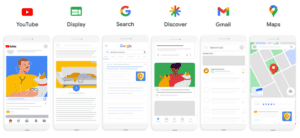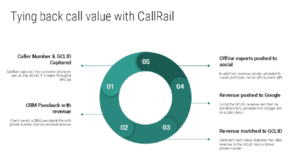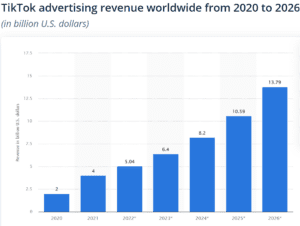In this article, we take a deeper look into the Google Ads trends that will have the biggest impact on search marketing and patient acquisition in 2023 and beyond. We also provide a framework that can help you remain competitive and ahead of the pack within this dynamic and rapidly changing environment. Here’s what we’ll cover:
Table of Contents
- The Impact of Global Economic Uncertainty on Ad Demand
- Performance Max Gains Acceptance (by Force?)
- Embrace Automated Marketing Solutions and AI-Powered Systems with Caution
- Lead Quality Controls are Mandatory
- New Platforms Are Gaining Market Share
- Ongoing Adaptations to Privacy Restrictions
- Keyword Strategy Is Evolving but Still Important
- New Google Ads Features
- Conclusion
Artificial intelligence (AI) and algorithmic machine learning solutions have rapidly improved over the last decade. Early AI applications were typically low-touch; they could only handle the simplest of inputs and responded with a limited and predetermined set of outputs. Newer AI-powered digital solutions, however, can now handle increasingly complex inputs and data sets and can analyze this information to extract meaningful and actionable insights and provide responses that ever more closely match human responses.
While these newer systems provide a great deal of value–in the form of lower operational costs, shorter response times, round-the-clock availability, and data-driven decision-making–they operate in a rapidly evolving market marked by large-scale changes that have a direct impact on their efficacy.
Without a strong understanding of how digital advertising tools manage and use data, it can negatively impact your cost per lead and cost per click. Also, some machine learning algorithms are designed to chase the lowest-hanging fruit in the pipeline, and we all know that all leads are not equal.
This is why ad management in the healthcare space cannot and should not be left entirely to machines.
Without human oversight and a deeper understanding of how changes in the advertising landscape, such as those mentioned above, can affect your bottom line, your campaigns can go awry, your marketing teams can miss their targets, and your advertising budgets can be totally spent without a commensurate rise in closed leads.
Now, let’s dig into the top 2023 PPC trends:
The Impact of Global Economic Uncertainty on Ad Demand
Advertising forecasts for 2022 and 2023 have already been substantially downgraded by many of the world’s leading quant and rating agencies. There is widespread global economic uncertainty heading into the winter, driven in part by the Russia-Ukraine war, the lingering effects of the COVID-19 pandemic (such as supply shortages), the ongoing energy crisis in the EU, rising interests rates, and labor shortages across most industries, to name just a few. These macro factors all paint a dire picture for advertising over the coming months.
What will all of this mean for marketers?
We’ve already seen many large corporations from Amazon to Klarna, Netflix, Carvana, Intel, and even investor darlings Apple and Robinhood institute hiring freezes–even layoffs–due to heightened budget scrutiny, slimmer margins, and bleaker outlooks as we continue through Q4 2022 and beyond. For marketers, this means decreased marketing and advertising budgets, stricter demands for better performance, and higher target ROIs from ad spending.
With these constraints, savvy marketers need to implement Google Ads optimizations if they want to maximize their healthcare budget.
In 2023, you must conduct routine campaign audits to ensure you’re not overlooking optimization opportunities. These audits allow you to refine keyword strategies by removing low-intent, low-quality keywords and better targeting relevant keywords.
Landing page optimizations (via, for example, enhanced user experiences and having unique landing pages for individual campaigns) and reevaluating how you bid (by, for example, combining manual and automatic bidding) can also help drive better outcomes. When done in tandem with other tried and tested strategies, such as remarketing, running competitor analysis, and sharing conversion data with ad platforms, you can build a sustainable process that brings high-intent, high-quality leads into your patient pipeline.
However, this is not enough, and in addition to revising your strategy to improve outcomes in a world of uncertainty, you should take things a step further by incorporating new lessons drawn from Google Ads trends to drive better results–even if you’re working with tighter marketing budgets than before. The first stop in that journey is understanding Performance Max.
Performance Max Gains Acceptance (by Force?)
At the end of 2021, Google rolled out Performance Max (PMAX) to all advertisers and announced its timeline to transition other campaign types to PMAX. As of September 2022, Smart Shopping campaigns must upgrade to Performance Max. Advertisers can do it themselves, or it’ll happen through an automatic upgrade.
Google’s ongoing march towards automation is evident, and the platform is giving users little choice in the matter. Throughout 2022, an increasing number of healthcare groups have embraced this new campaign type as a result.
The main difference between Performance Max and other campaign management offerings is that Performance Max allows media managers to buy Google Ads across YouTube, Display, Search, Discover, Gmail, and Maps from a single campaign. It’s a goal-based campaign type that uses AI to optimize performance in real-time across all channels using Smart Bidding.

This new campaign type from Google provides several advantages over other offerings.
First, it can increase online leads and conversions using automated and optimized budgets and bids across all of Google’s platforms, which makes it more efficient than manual or heavily segmented campaigns. Second, it does so in real-time, which can help you tweak your campaign parameters as needed and allows you to tap into real-time data on the intents and preferences of consumers. This can help you discover new audience segments while simultaneously helping you get your ads in front of those more interested shoppers.
PMAX works best when you have enough data for the algorithm to learn and optimize bidding and budgeting for your ads across different channels. It also works best when you have consolidated account structures in place so that data can be centralized and analyzed for actionable insights. If you do not spend enough or do not have enough data for the algorithm to mine, PMAX may not work for you.
On the flip side, while PMAX provides single-campaign optimization across all of Google’s advertising channels, users have almost no visibility into channel-specific performance and how client-provided assets you provide are used by the system. This makes it harder to make meaningful changes to campaigns and to see how different channels are performing.
Also, there are no channel-specific performance indicators for advertisers using PMAX, meaning you cannot tell if one campaign cannibalizes another. If having clear channel- or campaign-specific data is an important part of your strategy, then PMAX–even though it makes advertising across all of Google’s platforms easy and intuitive–may not be for you.
While PMAX’s automation and simplification of campaign management is a boon, it must be implemented carefully.
Embrace Automated Marketing Solutions and AI-Powered Systems with Caution
Advertising platforms provide marketers with access to huge audiences and highly integrated and performant solutions such as PMAX that allow them to run and test campaigns, gain user insights, and build robust patient acquisition pipelines.
However, at the end of the day, it is important to remember who Google serves: itself.
Google is a publicly-traded company. While delivering value-added and convenience to users has always been a big part of Google’s approach to business, the company’s bottom line is the most important measure of company success for its shareholders and C-suite executives. As such, it is important to look deeper into the guidelines and recommendations provided by Google before jumping on board and launching new campaigns and spending valuable advertising dollars if you do not know exactly how and where they will be spent.
For example, unless you specify a location to target or exclude in a campaign, Google can show your ads to users in locations that you are not capable of serving and may not be relevant to you. Even the placement of negative keywords matters. Negative keywords are keywords that can prevent your ad from being triggered. This means you may pay for a negative keyword, but it will only work if it appears within the first 10 words of a user’s search query. If it does not, but a user clicks your ad (since it will still be eligible for listing on the SERP), you will be charged even though your result does not apply to the user in question.
These are just two examples of corner cases in which Google’s cookie-cutter recommendations for advanced and automated ad management do not always work out in favor of the advertiser. This means you can use these solutions where they work for you, but you should approach them cautiously and take Google’s advice for running and automating your campaigns with a grain of salt.
Lead Quality Controls are Mandatory
Given the occasional shortcomings of black-box, ready-to-use solutions such as PMAX, you can generate more harm than good if you let an automated advertising algorithm run on its own and chase the easiest conversions.
Healthcare marketers must implement quality control measures to ensure that leads actually turn into new patients instead of having their systems chase more leads that don’t ever convert into new patients.
In other words, it’s essential to consider lead quality, not just lead quantity.
There are many reasons why ensuring lead quality is particularly important in the healthcare space.
- Lack of CRMs: The healthcare space is a slow adopter of customer relationship management (CRM) systems. Our healthcare marketing survey found that 47% do not have a CRM in place. Without a system to centralize customer data, it’s challenging to pass data back to Google to help its algorithms optimize performance.
- Poor Integrations: Related to the issue of a lack of an industry-wide CRM, there are poor data integrations between ad platforms, CRMs, and patient databases such as those built using electronic health records (EHRs) in the healthcare space.
- Multi-Channel Appointment Booking: Many patients book appointments over the phone, and this can be difficult to tie back to Google Ads, meaning an entire section of your incoming clients can be left out of your advertising metrics and KPIs.
- Lack of Conversion Values: Finally, with no conversion values assigned to leads, Google does not know which leads are more valuable and which ones should be chased. This is the crux of the problem regarding automated lead-gen and advertising systems and is a compelling reason for having human intervention as part of your acquisition strategy.
Now that we know the importance of having lead quality controls in place, the next section talks about how to implement such a system.
A Four-Step Lead Quality Strategy for Marketers
Healthcare groups can improve lead quality using a four-step strategy that works as follows:
- Evaluate the Leads You Are Already Creating: Examine your existing lead data to see where the good leads come from and where there’s room for improvement. Important metrics to analyze include the length of the buyer’s journey, their CTR, CVR, and CAC, and how much they contribute to your bottom line. Analyze call logs as well to identify common trends that result in a mismatch between you and a prospect.
- Learn How to Spot the Signs of Poor Lead Quality: Some of these signs include a mismatch between what the lead wants and what you offer; messaging that overpromises or inaccurately describes your offerings; and messaging that does not provide enough detail about your offerings.
- Invest in Improving Lead Quality: You can do this by researching and better understanding the ideal patient, which will tell you what they are looking for so that you can build a comprehensive keyword strategy around those needs. You should also define your Unique Selling Proposition (USP) so that you stand out from a sea of other service providers, which will help improve relevant conversions.
- Pass Conversion Data to Your Ad Platform: You can train the algorithms you use to show ads to those most likely to convert by telling them which leads actually turned into patients.

New Platforms Are Gaining Market Share
With the vast amount of value generated by online advertising, it was not a question of ‘if’ but more a question of ‘when’ new players would enter the PPC game. Several new and promising players are now competing with Google’s dominance in the online advertising space, and these players offer new channels for accessing potential patients, building demand for your brand, and capturing leads.
Amazon
Amazon cornered about 15% of the US digital ad market as of late last year, placing it behind Google (which had over 26% of the market) and Facebook (which had just over 24% of the market). In Q2 2022, Amazon grew faster than its leading rivals, thanks to ad revenue that jumped 18% from last year. Now generating approximately $9 billion in annual ad revenues, Amazon is a force to be reckoned with in digital advertising.
TikTok
TikTok generated about $4 billion in ad revenue last year. Its US revenues were about $2 billion, or about 1% of the total digital ad spending in the country. TikTok was the most widely downloaded app in the world in 2021 and is highly favored by Millennial and Gen Z users. It is also increasingly being used by influencers and creators to reach users and new markets.

Apple
Apple currently generates about $4 billion in digital ad revenues, equal to about 1.7% of US digital ad spending. Google, in comparison, will generate about $70 billion this year, and Facebook/Meta will generate about $55 billion. Tie-ins with Apple products and offerings (such as the App Store and AppleTV and especially ads optimized for iPhones and iPads – devices that are important parts of Apple’s users’ daily lives) promise to help the company generate more digital ad revenue over the years to come and should be considered by healthcare marketers as viable channels for advertising in 2023 and beyond.
We anticipate that these new platforms will chip away at Google’s dominance as marketers look for new avenues to reach niche audiences.
Ongoing Adaptations to Privacy Restrictions
Google Chrome plans to phase out cookie technology by 2024; though this deadline keeps getting pushed back, it is coming eventually. Apple’s iOS 14 update shook the marketing world in 2021, requiring apps to get permission before tracking certain types of user data. Google also announced that it is limiting the data that it shares with third parties to remain in compliance with the European GDPR.
These changes show that the world’s tech giants are listening to consumers and are committed to reducing data availability to advertisers.
These new restrictions will only increase over time, and they will have a considerable impact on the amount of data and targeting capabilities that healthcare advertisers have access to when developing campaigns.
Instead of being handicapped by these restrictions, smart marketers can embrace these new user- and privacy-focused rules by, for example, implementing new data collection strategies, integrating different data systems, A/B testing different ads and campaigns, and using better first-party data sources such as call tracking and mobile apps.
Read “Healthcare Marketing in the Era of Cookieless Browsing” to learn how to reach your ideal audience amid growing data restrictions.
Keyword Strategy Is Evolving but Still Important
Despite all of the changes and uncertainty talked about so far, keyword research will still be the foundation of your patient acquisition campaigns, though it is evolving each year. With decreasing targeting and audience-building capabilities, marketers must place a renewed focus on developing a deep understanding of their customers and how they search for information, solutions, and products.
What this means is that healthcare advertisers need to do what they do best, which is conduct research, dig into consumer behavior, and develop overarching messaging strategies that truly resonate with patients.
One way to do this is by simply listening to what your customers tell you. Call tracking and analytics software can help you understand how people search for care and what questions they have. Another way to gain patient insights is by monitoring forums and communities to uncover questions and needs that you can then incorporate into keyword strategy.
In the future, the importance of keywords as the foundation of PPC strategies will deteriorate, and advertisers–rather, the machines they use–will target potential customers based on signals from the system, serving ads to the audiences that have the highest probability of converting.
This means we are heading to a keywordless world, which means getting ad creative right will be even more critical than it is today, as will having automated systems with human oversight when implementing outreach campaigns in a more restrictive and competitive global environment.
New Google Ads Features
There are many new and important ad features released by Google in 2022 that directly affect healthcare marketers. For example, PMAX has changed how many existing offerings work, such as Smart Shopping, and Google Ads now allows image extensions on health and medical-related accounts. This adds a creative element to Google Ads for healthcare advertising, which has long been primarily text-based. It also allows healthcare groups to form better connections with searchers and can motivate advertisers to devise communication strategies that incorporate more imagery than before.
Other new Google Ads features include engaging with audiences based on the season with Discover ads; new text-to-speech features that allow the inclusion of voice-overs in ads; new, deeper diagnostic insights; better control over Smart Bidding; tools for more easily acquiring users who are more likely to engage with in-app ads using Target ROAS bidding; and new ways for measuring the impact of recommendations (perhaps because of feedback from the community on one of the shortcomings of PMAX mentioned above – the inability to see lead quality and which assets and ads in an automated campaign are driving the most business).
Conclusion
A lot is happening with Google Ads, and the Google Ads trends and strategies discussed above can help healthcare marketers use new automated offerings to their advantage while adapting to a rapidly changing world that is impacted by macroeconomic developments, new players entering the market, and new legal and compliance restrictions that are changing how the marketing game is played all over the world.
With the right understanding of the tools at your disposal and the smart use of these tools–as well as the critical component of human oversight somewhere along the process–digital marketers can enjoy the benefits of automation while retaining their focus on high-value leads. Combined with creative messaging and end-to-end strategies that can iteratively bring more and more quality leads into the pipeline, smart adaptation to the Google Ads trends and PPC recommendations above can be the difference between struggling in a world of smaller marketing budgets and rising to the occasion by driving more business by smartly pivoting to proven strategies to stay ahead of the pack.

